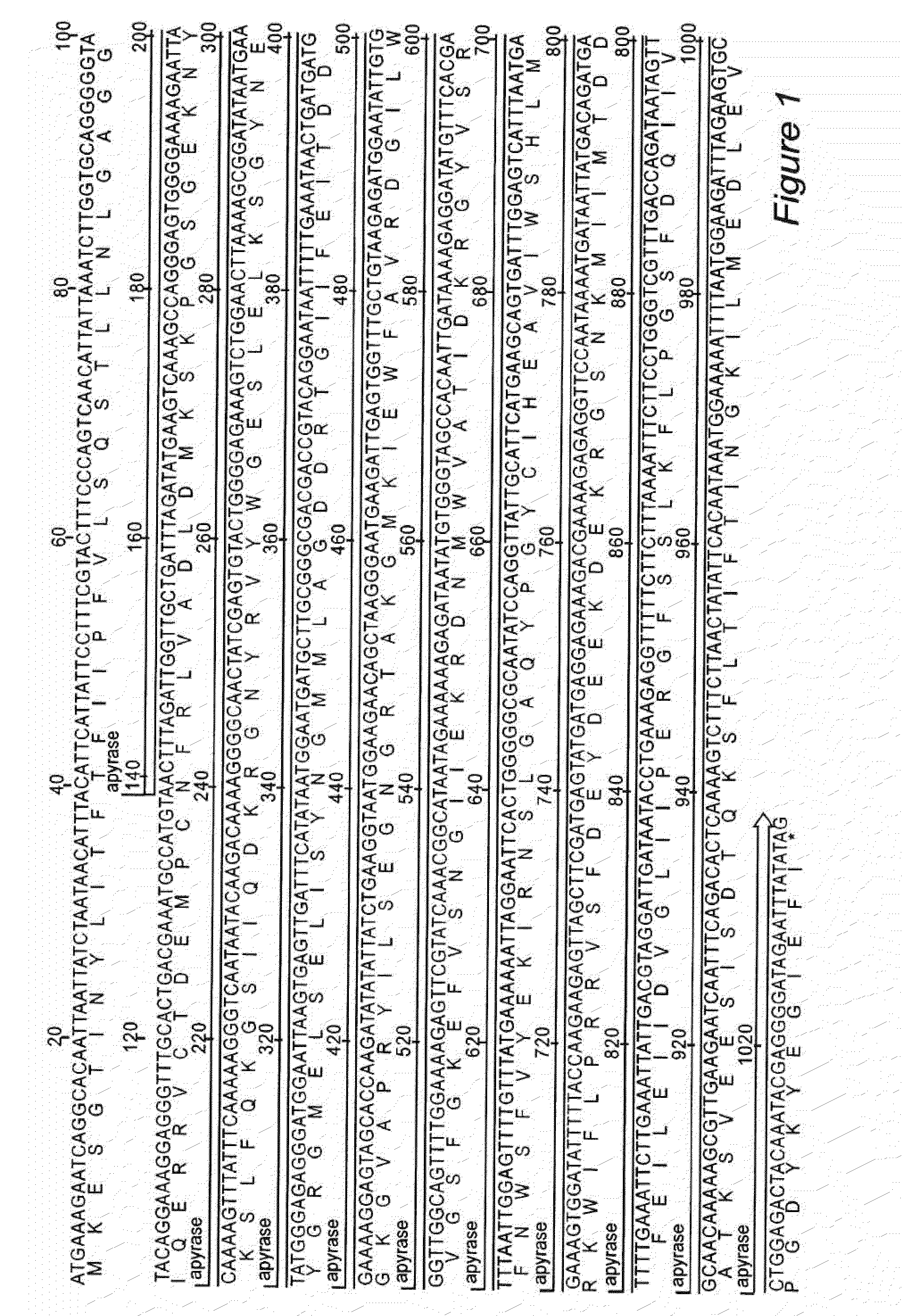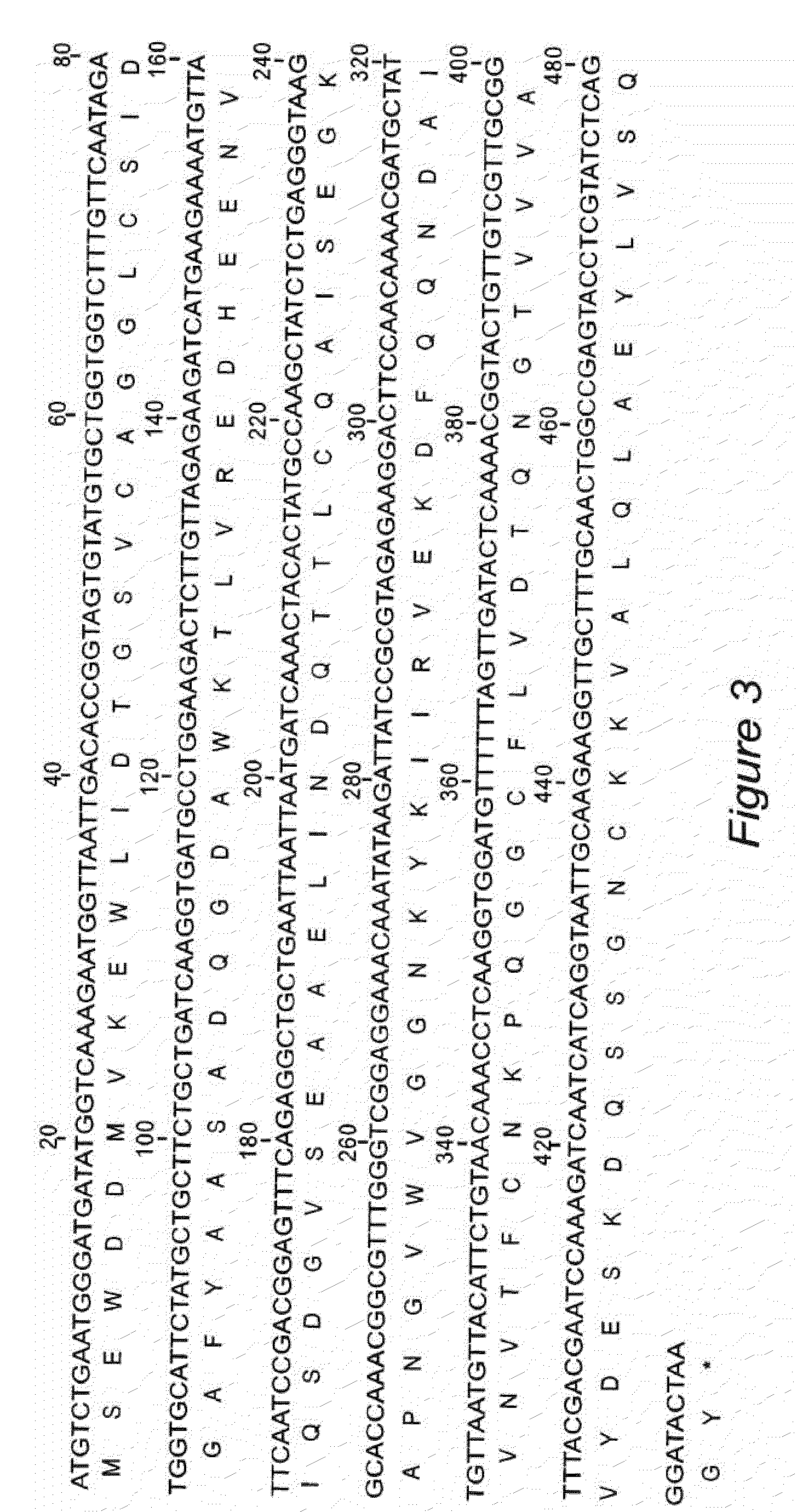Vaccine targets and delivery systems for cryptosporidium
a cryptosporidium and vaccine technology, applied in the field of vaccines against cryptosporidium, can solve the problems of cryptosporidiosis, cryptosporidiosis has a devastating, often lasting impact on immunocompromised or malnourished individuals, accidental contamination of lakes, rivers, etc., and achieves the effect of reducing the shedding of cryptosporidium oocysts and reducing the number of cryptosporidium oocysts
- Summary
- Abstract
- Description
- Claims
- Application Information
AI Technical Summary
Benefits of technology
Problems solved by technology
Method used
Image
Examples
example 1
Experiments Involving Antigen SRK
[0055]SRK expressed in bacterial expression systems. The SRK gene was ligated into pTriEX4 (His-Tag), pET41 (GST-Tag), and pET44 (Nus-Tag) Escherichia coli (E. coli) expression vectors and pSEC10 ClyA Salmonella live vaccine vector (Galen J. E., Zhao L., Chinchilla M., Wang J. Y., Pasetti M. F., Green J., et al. (2004) Adaptation of the endogenous Salmonella enterica serovar Typhi clyA-encoded hemolysin for antigen export enhances the immunogenicity of anthrax protective antigen domain 4 expressed by the attenuated live-vector vaccine strain CVD 908-htrA. Infect. Immun. 72, 7096-7106). and expressed using standard protocols. The results of these overexpression experiments are summarized in Table 1, and polyacrylamide gel electrophoresis results are presented in FIGS. 4A and B. As can be seen, SRK is expressed strongly in pTriEX4 (FIG. 4A, lane 3) and pSEC10 ClyA (FIG. 4B, lane 8).
TABLE 1pTriEX4pET41pET44pSEC10MWFunc-(His-Tag)(GST-Tag)(Nus-Tag)ClyA(kD...
example 2
Experiments Involving Antigen CP15
[0065]Cp15 expressed in bacterial expression systems. The Cp15 gene was ligated into pTriEX4 (His-Tag), pET41 (GST-Tag), and pET44 (Nus-Tag) E. coli expression vectors and pSEC10 ClyA Salmonella live vaccine vector as described above and expressed using standard protocols. The results of these overexpression experiments are summarized in Table 2, and polyacrylamide gel electrophoresis results are presented in FIGS. 4A and B. As can be seen, CP15 is expressed very well in pTriEX4 (FIG. 4A, lane 2) and pSEC10 ClyA (FIG. 4B, lane 7).
TABLE 2pTriEX4pET41pET44pSEC10MWFunc-(His-Tag)(GST-Tag)(Nus-Tag)ClyA(kDationclonedclonedclonedSalmonellaexpressedexpressedexpressed17Attach-+ Insoluble+ Insoluble+ Soluble+ment
[0066]Antibodies immunolocalize Cp15 to membrane and block invasion in tissue culture. These antibodies were used to block invasion of cultured human intestinal epithelial cells (HCT8 cell line) by Cryptosporidium. The antibodies showed significant in...
example 3
Experiments Involving the Profilin Antigen
[0071]Profilin expressed in bacterial expression systems. The profilin gene was ligated into pTriEX4 (His-Tag), pET41 (GST-Tag), and pET44 (Nus-Tag) E. coli expression vectors and pSEC10 ClyA Salmonella live vaccine vector (as described above) and expressed using standard protocols. The results of these overexpression experiments are summarized in Table 3 and polyacrylamide gel electrophoresis results are presented in FIGS. 4A and B. As can be seen, profilin is expressed very well in pTriEX4 (FIG. 4A, lane 1) and pSEC10 ClyA (FIG. 4B, lane 6).
TABLE 3pTriEX4pET41pET44pSEC10MWFunc-(His-Tag)(GST-Tag)(Nus-Tag)ClyA(kDationclonedclonedclonedSalmonellaexpressedexpressedexpressed20Cyto-+ SolubleNot done+ Soluble+skeleton
[0072]These bacterial expression systems thus permit large scale production of profilin protein, and the pSEC10 ClyA fusion vector permits delivery of the antigen in a live secreting bacterial vector intranasally in animal models.
[00...
PUM
| Property | Measurement | Unit |
|---|---|---|
| body weight | aaaaa | aaaaa |
| body weight | aaaaa | aaaaa |
| nucleic acid | aaaaa | aaaaa |
Abstract
Description
Claims
Application Information
 Login to View More
Login to View More - R&D
- Intellectual Property
- Life Sciences
- Materials
- Tech Scout
- Unparalleled Data Quality
- Higher Quality Content
- 60% Fewer Hallucinations
Browse by: Latest US Patents, China's latest patents, Technical Efficacy Thesaurus, Application Domain, Technology Topic, Popular Technical Reports.
© 2025 PatSnap. All rights reserved.Legal|Privacy policy|Modern Slavery Act Transparency Statement|Sitemap|About US| Contact US: help@patsnap.com



